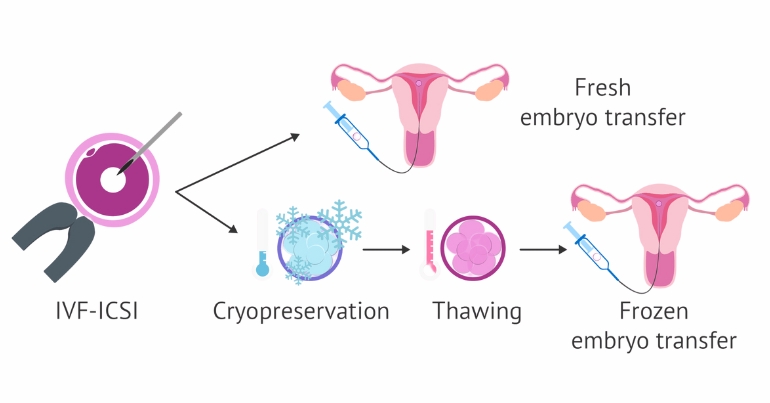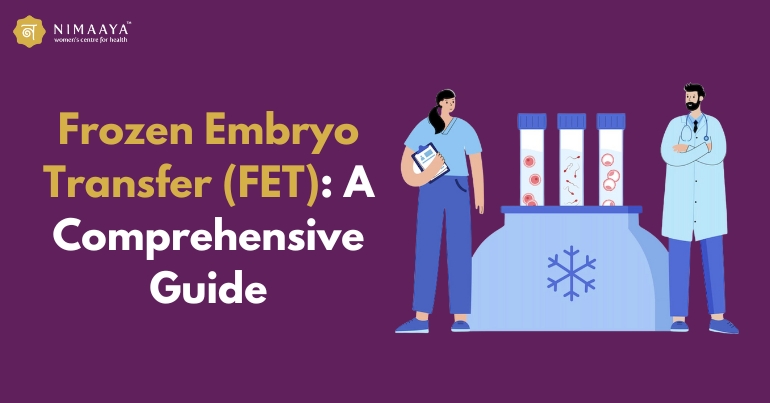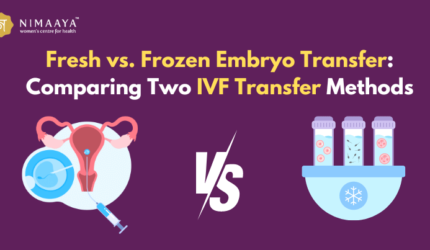Have you ever come across the term FET?
Most probably, it would be a No. If you answered Yes, you might not know what the term exactly means and probably have multiple questions about how it will help you in your journey toward parenthood.
To address all these questions, we will study the blog that covers outlines such as the FET process, including FET risks, FET benefits, and FET challenges that couples often face when choosing Frozen embryo transfer.
We at Nimaaya, make sure to guide you at each step of the FET process thoroughly.
What is FET?
Frozen embryo transfer (FET) occurs mainly during IVF if there is an excess production of embryos or if there is a previous failure in successfully transferring embryos.
In such cases, the embryos are frozen and can be later transferred into the woman’s uterus if the initial cycle has failed. This procedure is known as the FET process.
There are two types of FET cycles within IVF:
• Natural Support Cycle
This process is not most commonly preferred because it relies on natural ovulation. However, to make it successful, an hCG shot is often administered to ensure ovulation occurs.
• Hormonal Support Cycle
It refers to the cycle that is usually preferred by couples and clinics because it is easy to support, and control for hormonal support is available for ovulatory problems. The process is preferred by women who have irregular periods.
Also Read: Fresh vs. Frozen Embryo Transfer
FET Process

① Hormone Medication
The FET process begins with the administration of hormonal medication to prepare the woman’s uterus for embryo implantation. These medications typically include estrogen, which stimulates the growth of the uterine lining, further preparing it for the embryo.
② Embryo Thawing
Once the woman’s uterine lining is adequately prepared, the frozen embryos are carefully thawed. The embryo thawing process requires precise temperature control to ensure the viability of the embryos. During this stage, the embryologist will carefully monitor and assess the embryos to ensure that they survive through the thawing process.
③ Embryo Transfer
The thawed embryos are then transferred into the woman’s uterus. The procedure is similar to a regular embryo transfer in IVF, with the only difference being the use of a catheter to gently place the embryo into the uterine cavity. In some cases, ultrasound may be used to ensure accurate placement.
④ Hormonal Analyses and Pregnancy Tests
Following the embryo transfer, hormonal analyses are continued to monitor hormone levels. These analyses play a crucial role in assessing the viability of the pregnancy. Typically, after 10 to 14 days of embryo transfer, it will confirm whether the pregnancy has been successful.
Also Read: Understanding In-Depth the FET Procedure
Reasons to choose FET
The FET is suggested by IVF specialists when you have certain health conditions or any lifestyle problem that will help you get pregnant.
Ⓐ Embryo Transfer
It is essential to transfer one or several embryos from an IVF procedure but remember to transfer it one or two at a time. This approach helps mitigate the risks of multiple pregnancies.
To further reduce the risk, doctors might recommend elective single embryo transfer (eSET).
After your IVF cycle, this is done to freeze extra embryos. If the transferred embryo does not result in a successful pregnancy, then FET cost would be the most preferred option to transfer previously frozen embryos.
Ⓑ Having Another Child
Couples who have successfully undergone IVF or other fertility treatments and now wish to have another child may opt for embryo transfer. Since there are often frozen embryos left from the previous IVF cycle, they can be thawed and transferred to the uterus during the subsequent cycle. This approach potentially increases the chances of successful pregnancy without a need to repeat the entire IVF cycle.
Ⓒ Using Genetic Screening
The FET embryo quality is checked when genetic screening, known as preimplantation genetic testing (PGT), is conducted to identify genetic abnormalities in embryos before transferring them to the uterus. This screening process is beneficial for couples who are known to have any genetic disorder history in the past. So, through this procedure, you can reduce the risk of passing these genetic problems to your children.
Risk or Problem with FET
There is a high chance that none of your embryos will be suitable for freezing, so at the end of the day there will be no embryos to transfer. During the embryo transfer procedure, there might be chances of cramping, discomfort, or bleeding.
Moreover, there is a risk of getting an infection associated with the process. When multiple embryos are placed into the uterus, there is an increased risk of multiple gestation. The risk of FET may include:
- Premature birth of the baby
- Early birth with potential survival challenges
- Increased likelihood of preterm labor
- A higher risk for bleeding, infection, and the need for a cesarean section during delivery.
Also Read: Preparing for FET: Lifestyle Changes and Pre-Treatment Considerations
FET Success Rates
The success rate of frozen embryo transfer (FET) depends on numerous factors, which we will explore one by one:
‣ Embryo Quality
Along with the number of embryos, the quality of embryos is also a factor to be considered. The embryo quality determines the FET success rate. High-quality embryos may have successful chances of getting pregnant and implanting the embryos successfully.
‣ Age of the Recipient
One of the FET benefits for couples is when they are at a young age. Younger couples tend to experience higher success rates due to healthier eggs and a more receptive uterus. On the other hand, as age increases, fertility tends to decrease, leading to a decreased chance of successful implantation.
‣ Medical Conditions
Certain medical conditions, such as PCOS and uterine abnormalities, significantly impact FET success rates. Addressing these conditions before undergoing FET can improve the chances of a successful outcome.
At Nimaaya, we conduct a thorough medical checkup and consultation with couples aspiring to become parents before commencing the FET process. Throughout the process, we make sure that the individuals are free from any past medical history that might bring a hurdle during the FET.
‣ Previous Pregnancy History
Another factor that contributes to the FET success rate is a history of successful pregnancies, whether through natural conception or assisted productive technology. Having a positive previous pregnancy history can enhance the chances of FET success.
Nimaaya continuously enhances its FET success rates through advancement in technology and the expertise of our doctors, who have excelled in the field for the past few decades. Our motto is to continuously work on improving the success rate of FET and fulfill the parent’s dream of having their own extended family.
Frozen Embryo Transfer Challenges
FETs involve preparing the uterine lining with hormones. The process begins with the use of estrogen to thicken the lining, followed by simultaneous administration of progesterone to produce the changes necessary for an embryo to implant. But remember, during this process, couples often go through:
• Thin Uterine Lining
Irrespective of any fertility treatment, there are higher chances of unsuccessful pregnancy because of the thin uterine lining in women’s uterus.
There are different treatments given to treat the uterine lining such as increasing the chances of dose of estrogen, taking supplement medications, and canceling the embryo transfer. However, irrespective of the field, there are higher chances of it getting FET failure due to a thin uterine lining.
The catch here is that there are also chances of getting pregnant even with a thin lining.
• Unexpected Ovulation
To successfully get embryos implanted into the uterus, they must be placed within a specific window of implantation. Talking about The perfect timing is based on taking the progesterone that reaches the uterine lining.
After progesterone is administered, the FET specialist knows when it will be the correct time to place the embryos.
However, if you were to ovulate, you would start producing progesterone earlier than expected which will eventually shift the window of the implantation. For this reason, many doctors worldwide try to use medications to try to prevent unexpected ovulation.
• Timing for Embryo Transfer
One of the challenges associated with frozen embryo transfer lies in determining the optimal timing for successfully transferring the thawed embryos into the uterus. The timing here plays a crucial role because it needs to align with the woman’s menstrual cycle and the receptivity of her uterine lining.
The major challenge arises when synchronizing the readiness of the thawed embryos with the specific window of uterine receptivity. This situation occurs when the uterine lining is in its most receptive state, providing the most suitable environment for the embryo to attach and implant.
For a successful FET, the embryo should be transferred to the uterus during a specific phase of the menstrual cycle known as the implantation window.
• Fluid in the Uterine Cavity
The uterine lining continually produces fluid, and some of it is reabsorbed by cells within the uterine lining. However, there are two possibilities for this fluid: It may leak out of the uterus through the vagina, or it may leak out of the fallopian tubes into the abdomen.
The accumulation of the fluid in the uterine cavity indicates that the fallopian tubes may be blocked, and the tubes will be filled with fluid. This condition can result in a low pregnancy rate or IVF cycle. Now, to treat this perform a surgery and remove the fallopian tubes that will automatically increase the chances of pregnancy.
Summary
Frozen embryo transfer is primarily focused on the successful production and transfer of additional embryos. It’s all about making the process successful, analyzing the risk associated, studying the challenges associated, and why and when one should go for FET.
Ultimately, whether you choose FET or another fertility treatment, the chances of achieving pregnancy and completing your family are significantly enhanced.
Choose your fertility treatment wisely, Nimaaya will help you consult one of the best IVF specialists who has been in the industry for decades. After all, we believe in guiding in depth and providing the best method that suits your requirements.
Still waiting? Consult them today!




